The seventh edition of Ibrida, the International Festival of Intermedia Arts organized by the artists Francesca Leoni and Davide Mastrangelo in the EXATR venue, a hub devoted to contemporary arts located in the city center of Forlì and housed in the spaces of a large S.I.T.A. warehouse. The engine of the project is always a survey of the most up-to-date artistic production in the field of experimental audiovisual and its potential for contamination with other disciplines, such as performance art, installation and electronic music. The event kept unchanged the consolidated format, which provides for the alternation of live, interactive works and projections (with two distinct programs, one in presence and one freely accessible in streaming through the official website during the festival). As always, the two artistic directors paid great attention to the active involvement of media representatives and the theoretical contribution of experts in the field, with the aim of contributing to the definition of an object of investigation that appears elusive and little known to the general public, both for the fact that even today its diffusion seems linked above all to niche festivals or diluted by the dispersion of the internet, and because by its nature it is a creative environment whose constant and rapid transformation seems to make every attempt at critic systematization “anachronistic in advance”.
The Saturday talks, based on dialogue and sharing rather than frontal communication, started with Domenico Quaranta[1], author of essays that in recent years are becoming a national and international point of reference on the theme of the most advanced technological media in relation to contemporary artistic practices. On this occasion, the young critic and curator was asked about the NFT (Non Fungible Token, digital certificates of authenticity) which at the beginning of 2021 opened the debate on the blockchain in the art world. It was then the turn of the meeting with the representatives of the contemporary art media, in which Juliet was involved together with Exibart, Segno and Arshake in a reflection on the problems and possibilities of the contemporary art communication in a post-pandemic era characterized by uncertainties and digital bulimia, in which the need for synthesis and clarity collides with the market logic and with the crumbling of the most consolidated reference parameters.
The theme that guided the selection of the artistic proposals of this edition is that of digital identity, declined in the Videoart Yearbook sections. The yearbook of Italian video art (curated by a renewed research group consisting of Renato Barilli, Piero Deggiovanni, Pasquale Fameli and Silvia Grandi), The Next Generation short film festival, created in partnership with the homonymous competition for emerging filmmakers based in Bari and Segnali, curated by Vertov Project. Among the videos that we were able to see (the proposal is very wide and unfortunately the gift of ubiquity is still precluded to us, at least until the hybridization between virtual and real does not allow us to overcome even this limit) we are pleased to report first of all Paradise Lost by Francesca Fini, a bewitching fable of creation and destruction in which a sumptuous computerized deity seems to play with its own emanations and then dematerialize them with an unexpected sound of shattered glass. Then we were struck by the digital farm by Ophelia Borghesan, who in Milk is good for bones shows a surreal production chain in which the dematerialization and the surgical ostentation of well-being suggest a background of new and mysterious cruelties. Undoubtedly, The gleaners, and: ritual for signaled bodies by Benjamin Rosenthal + Eric Souther, a lysergic saga of bodies crossed and shaped by color and sound in a hybrid setting between the placenta and the rave party deserves mention.
The interactive works, also related to the theme of digital identity, were installed in a new area of EXATR recently recovered after the safety works financed by the Emilia-Romagna Region, a evocative industrial archeology building which in the current state of work in progress was the perfect scenario to amplify the space-time indeterminacy of the works on display. To welcome us at the entrance we found Tutte le volte che by Francesca Lolli, a vintage living room stuffed with stones in which the viewer is invited to sit in front of a cathode ray tube television that transmits images of artificial well-being, similar to advertising or idealized memories, repeatedly interrupted by the attempts of a woman who, noticing the presence of someone on the other side of the screen, tries to communicate some thoughts taken from the text “Feminism and Anarchy” by Emma Goldman (1910), systematically censored by signal disturbances. The phone placed next to chair fails to ring to put us in communication with her when she tries to call us to overcome the screen barrier, but her alarm message is more eloquent than ever. An alert state is also evoked by Igor Imhoff with Eyes # 41, interactive software that, using the most advanced surveillance technologies, identifies and scans whoever enters its range, assigning codes to every movement, expression or direction of the gaze, which are returned in the form of numerical and visual information. Wearing a special viewer, the viewer is able to see himself/herself as a set of data and representations as if looking from inside the artificial intelligence and, from whichever side he/she turns, is threatened by an ironic video game monster head. The atmosphere is tempered with the Peep show box by Rino Stefano Tagliafierro, a refined display device that associates the same voyeurism with erotic or “innocent” details of nineteenth-century paintings, in an implicit suggestion that only an intimate and desire-filled relationship with the art allows us to fully appreciate it. Apparently light-hearted, but intelligently existentialist, the installation Bertrando & Bernardo by Francesco Selvi + Matteo Pini, which through the comic curtains of two cartoonistically stylized Siamese twins stages the theme of incommunicability and the split between oneself and the other from self.
The live show on Saturday presented in (almost) preview Otis, vertical tales, a new audiovisual work by Økapi aka Filippo E. Paolini. The work takes as a pretext a tribute to the safety lift, a mechanism invented in the mid-nineteenth century by Otis Elisha Graves to allow a quick passage between the various levels of buildings that were becoming increasingly stratified in height, to superimpose fifteen floors of parallel universes of an imaginary building inhabited by scenes taken from famous films, in turn fragmented into clips that interrupt their consequentiality, transforming it into co-presence. The connection between one floor and another is made by real elevator operators filmed around the world by the artist, who here seem to acquire an even more canonical stage presence than the excerpts of fictions that connect with their work. The vertical journey suggested by the title, on the other hand, is mental and multidimensional, significantly accompanied by the sound live performed by the artist. Dj Balli + Vj Federico Bigi (Sublime Tecnologico) concluded the evening with an engaging dj set played in front of a big screen that at times seemed to grow bigger like a tribal idol.
[1] In 2018 Luciano Marucci dedicated an extensive interview on the subject to Domenico Quaranta, which we recall here: www.juliet-artmagazine.com/en/domenico-quaranta-and-the-future-of-new-technologies
Info:
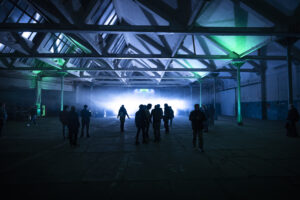
Graduated in art history at DAMS in Bologna, city where she continued to live and work, she specialized in Siena with Enrico Crispolti. Curious and attentive to the becoming of the contemporary, she believes in the power of art to make life more interesting and she loves to explore its latest trends through dialogue with artists, curators and gallery owners. She considers writing a form of reasoning and analysis that reconstructs the connection between the artist’s creative path and the surrounding context.


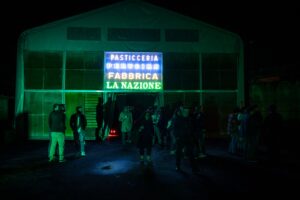 Ibrida Festival 2022, ph.
Ibrida Festival 2022, ph. 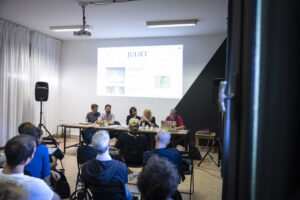 Art Magazines talk III, ph.
Art Magazines talk III, ph. 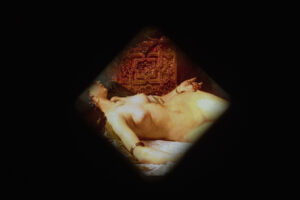 Rino Stefano Tagliafierro, Peep show box, ph.
Rino Stefano Tagliafierro, Peep show box, ph. 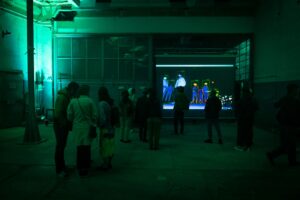 Igor Imhoff, Eyes #41, installation view at EXATR, Deposito, ph.
Igor Imhoff, Eyes #41, installation view at EXATR, Deposito, ph. 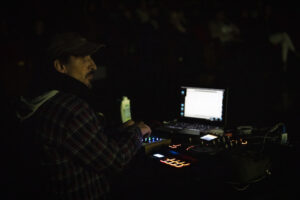 ØkapI aka Filippo E. Paolini, Otis, vertical tales, live, ph.
ØkapI aka Filippo E. Paolini, Otis, vertical tales, live, ph. 



NO COMMENT